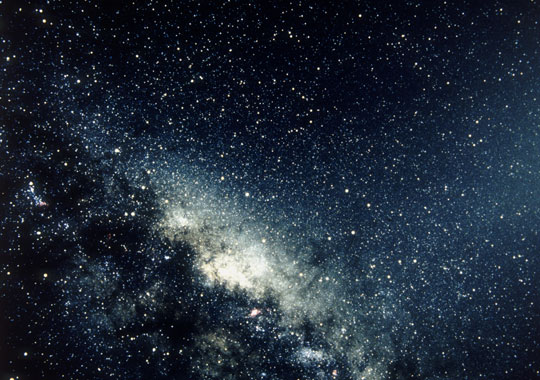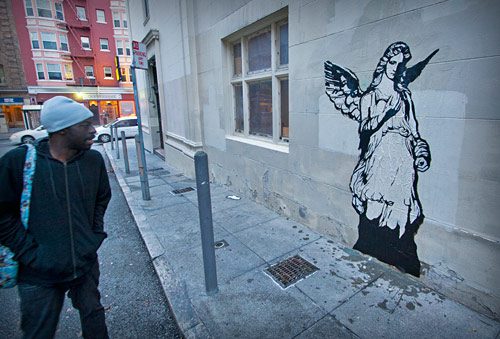
The common view of religious conversion seems to be this: There are many ways one can stumble towards the gentleman we call God. And on the surface, I agree. After all, rainbows and relationships have lead men to faith, as have Holocausts and heartaches. Collins converted at the sight of beauty; Walker Percy at the sight of a Jew in New York City. Dorothy Day became a Catholic by a series of small and slow steps; St. Paul by one big fall, simultaneously off and onto his ass.
But it is necessary to dive deeper. For a rainbow is meaningless without our light-translating eyes, as is a relationship without our participation. A Holocaust is horrifying, but only if we have the heart to be horrified. In each instance of conversion the Self is the thing that matters. To say it coherently: A conversion occurs because an external event reveals the truth about the internal self. There may be multiple and varying facets of conversion, but there only one way to conversion, and that is through the human person. Namely, you.
And does this not make sense? The Blessed Sacrament aside, what is the most perfect image of God on earth? Where is the evidence for his existence? I hold that the greatest mass of evidence for the existence of the Creator lies in the strange creatures said to be made in his image and likeness. Ourselves. You want God? Look in.
Conversion, then, can be described quite simply as an act of seeing ourselves. Not looking at ourselves, mind you. We do that way too often, an act of bogus self-assessment, an intentional glance in a mirror and a ridiculous summation of all the things that don’t matter one bit: “I’m Joe, I work in a factory, I listen to hipster music, I look good in these jeans, I’m a social conservative…”
No, no, no. Conversion is seeing ourselves, all our shams and poses stripped away. Conversion to the Jew-God-Belief must be akin to accidentally looking in a mirror, to seeing ourselves as if for the first time, to walking down the street, looking into a shop window, stopping, and thinking “Who the hell is that? He looks so – ah. It is I.”
Take the example of the Universe surrounding us. There are two ways to go about it: One is to look – and you will walk away an atheist – and the other is to see – and you will walk away a believer.

Individual One looks up at the night sky and calls to mind several facts – the light from
the stars travels through both space and time to reach his eyes, the earth is not the center of the universe, in fact, it is not even a dust-mite in the universe, the Milky Way is 100,000 light years in diameter, we cannot comprehend the vastness of space, we are alone on this rock, it’s all so meaningless, how can there be a God who hold us in high esteem? Individual One looks, he makes his assessment; there is no conversion.
Individual Two looks up at the night sky and recalls the exact same facts. He too is struck by the apparent infinity of the universe, the utter worthlessness and laughable unimportance of the World. But then something happens: He turns and accidentally faces a mirror. What makes the 1000 light-year galaxy so tremendously great? It is not the number – who can conceptualize such a size? It is not the thing itself, for there is no rational reason we should be impressed by a Very Big Thing any more than a Very Small Thing. “What on earth? Ah – it is I.”
There is no conception of Frightfully Huge without me to project that conception. A planet might be larger than other planets, but it takes a human person to give it the quality of Unimaginably, Awfully Larger. As C.S. Lewis says,

“To puny man, the great nebula in Andromeda owes in a sense its greatness.”
There is no reason the size of the Earth makes it an unimportant dust-mite other than the fact that I have a conception of importance and of dust-mites, and I have given it to the universe around me.
If we were only material creatures, we would look at the distance between us and our workplace; 5 miles. We would look at the distance between us and the farthest galaxies we can see; approx. 1000000000 light years. We would move on; two distances, one much larger than the other, absolutely nothing more to it. But what does the mirror actually show? People freaking out, falling on their knees in despair over such a distance. People looking up and contemplating their existence.
In short, our actions admit that we apply the Spiritual to the world around us. They admit that we are spiritual creatures. The man pointing to the skies and saying our existence is meaningless is the greatest proof I can offer that our existence is meaningful. Conversion happens as a result of this – realizing there exists within you the conceptions of awe and majesty and terror and horror and that these are not of this world. What animal is thrown into existential crisis over the size of a mountain? What rational reason do we have to be awed?
So to the Christian hoping to win converts, the point is this: The overused, “How can you not believe in God? Have you never seen a sunset?” is close, but not close enough. The real question is, “How can you not believe in God? Have you never seen yourself seeing a sunset?”
To my Catholic readers, the point is this: We must show man himself. We must create beauty. What is art – poetry, painting, great novels, music, movies, myth – but a mirror held up in the face of man, calling him to “know thyself”? What is the experience of being overwhelmed by beauty but the acknowledgment that there exists That Which Is Too Much For Me? And if that does indeed exist, why on earth would I be able to acknowledge it, unless by some incredible and strange fact I am made in the image and likeness of That Which Is Too Much For Me?
To my atheist readers: convert.











